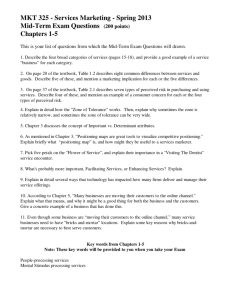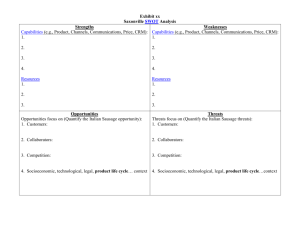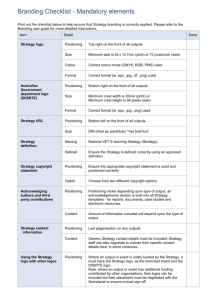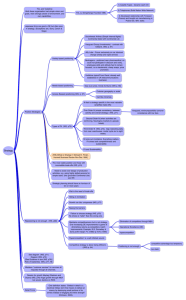Ramakrishna Mohan Rao Munaga TM FEB 2015
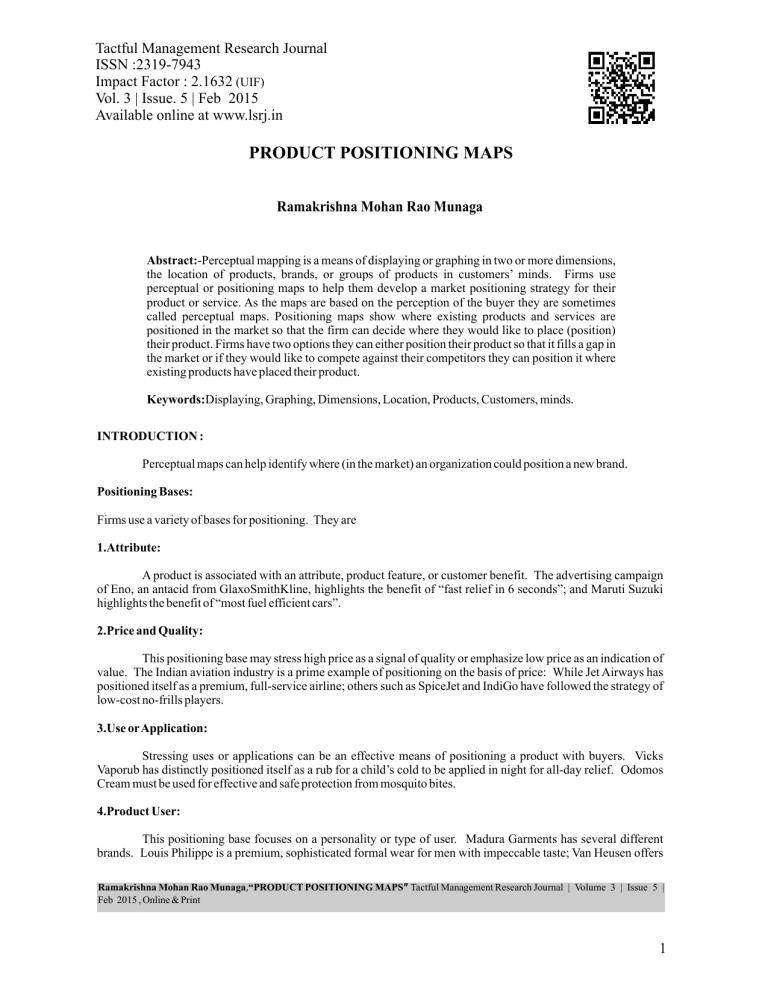
Tactful Management Research Journal
ISSN :2319-7943
Impact Factor : 2.1632
(UIF)
Vol. 3 | Issue. 5 | Feb 2015
Available online at www.lsrj.in
PRODUCT POSITIONING MAPS
Ramakrishna Mohan Rao Munaga
Abstract: -Perceptual mapping is a means of displaying or graphing in two or more dimensions, the location of products, brands, or groups of products in customers’ minds. Firms use perceptual or positioning maps to help them develop a market positioning strategy for their product or service. As the maps are based on the perception of the buyer they are sometimes called perceptual maps. Positioning maps show where existing products and services are positioned in the market so that the firm can decide where they would like to place (position) their product. Firms have two options they can either position their product so that it fills a gap in the market or if they would like to compete against their competitors they can position it where existing products have placed their product.
Keywords: Displaying, Graphing, Dimensions, Location, Products, Customers, minds.
INTRODUCTION :
Perceptual maps can help identify where (in the market) an organization could position a new brand.
Positioning Bases:
Firms use a variety of bases for positioning. They are
1.Attribute:
A product is associated with an attribute, product feature, or customer benefit. The advertising campaign of Eno, an antacid from GlaxoSmithKline, highlights the benefit of “fast relief in 6 seconds”; and Maruti Suzuki highlights the benefit of “most fuel efficient cars”.
2.Price and Quality:
This positioning base may stress high price as a signal of quality or emphasize low price as an indication of value. The Indian aviation industry is a prime example of positioning on the basis of price: While Jet Airways has positioned itself as a premium, full-service airline; others such as SpiceJet and IndiGo have followed the strategy of low-cost no-frills players.
3.Use or Application:
Stressing uses or applications can be an effective means of positioning a product with buyers. Vicks
Vaporub has distinctly positioned itself as a rub for a child’s cold to be applied in night for all-day relief. Odomos
Cream must be used for effective and safe protection from mosquito bites.
4.Product User:
This positioning base focuses on a personality or type of user. Madura Garments has several different brands. Louis Philippe is a premium, sophisticated formal wear for men with impeccable taste; Van Heusen offers
Ramakrishna Mohan Rao Munaga , “PRODUCT POSITIONING MAPS ” Tactful Management Research Journal | Volume 3 | Issue 5 |
Feb 2015 , Online & Print
1
.
PRODUCT POSITIONING MAPS formal executive wear for 25-45 years old professionals; Allen Solly introduced the concept of Friday Dressing and offers premium casual wear; and Peter England is a mid-priced formal wear, offering value for money range for young men who have just started their career.
SUMMARY
We must remember that perceptual maps are based on the buyer's perception this is challenging: what may be viewed as a quality product by one buyer, may not be perceived as a quality product by another buyer. Perceptual maps help firms understand how customers view their products. However as perception is very subjective, firms need to ensure that the data they use to plot the map is accurate. If customer perception data is wrong, the map will be wrong and this will affect the success of any marketing strategy based on the perceptual (positioning) map.
Perceptual maps may help organizations identify gaps in the market. Before deciding to fill any gaps in the market firms need to ensure that there is likely to be a demand for a product positioned in that gap.
REFERENCES:
1.Learn Marketing
Ramakrishna Mohan Rao Munaga
Tactful Management Research Journal | Volume 3 | Issue 5 | Feb 2015
